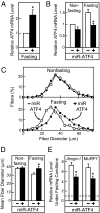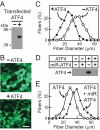The transcription factor ATF4 promotes skeletal myofiber atrophy during fasting
- PMID: 20197309
- PMCID: PMC2852358
- DOI: 10.1210/me.2009-0345
The transcription factor ATF4 promotes skeletal myofiber atrophy during fasting
Abstract
Prolonged fasting alters skeletal muscle gene expression in a manner that promotes myofiber atrophy, but the underlying mechanisms are not fully understood. Here, we examined the potential role of activating transcription factor 4 (ATF4), a transcription factor with an evolutionarily ancient role in the cellular response to starvation. In mouse skeletal muscle, fasting increases the level of ATF4 mRNA. To determine whether increased ATF4 expression was required for myofiber atrophy, we reduced ATF4 expression with an inhibitory RNA targeting ATF4 and found that it reduced myofiber atrophy during fasting. Likewise, reducing the fasting level of ATF4 mRNA with a phosphorylation-resistant form of eukaryotic initiation factor 2alpha decreased myofiber atrophy. To determine whether ATF4 was sufficient to reduce myofiber size, we overexpressed ATF4 and found that it reduced myofiber size in the absence of fasting. In contrast, a transcriptionally inactive ATF4 construct did not reduce myofiber size, suggesting a requirement for ATF4-mediated transcriptional regulation. To begin to determine the mechanism of ATF4-mediated myofiber atrophy, we compared the effects of fasting and ATF4 overexpression on global skeletal muscle mRNA expression. Interestingly, expression of ATF4 increased a small subset of five fasting-responsive mRNAs, including four of the 15 mRNAs most highly induced by fasting. These five mRNAs encode proteins previously implicated in growth suppression (p21(Cip1/Waf1), GADD45alpha, and PW1/Peg3) or titin-based stress signaling [muscle LIM protein (MLP) and cardiac ankyrin repeat protein (CARP)]. Taken together, these data identify ATF4 as a novel mediator of skeletal myofiber atrophy during starvation.
Figures





Similar articles
-
Role of ATF4 in skeletal muscle atrophy.Curr Opin Clin Nutr Metab Care. 2017 May;20(3):164-168. doi: 10.1097/MCO.0000000000000362. Curr Opin Clin Nutr Metab Care. 2017. PMID: 28376050 Review.
-
Identification and Small Molecule Inhibition of an Activating Transcription Factor 4 (ATF4)-dependent Pathway to Age-related Skeletal Muscle Weakness and Atrophy.J Biol Chem. 2015 Oct 16;290(42):25497-511. doi: 10.1074/jbc.M115.681445. Epub 2015 Sep 3. J Biol Chem. 2015. PMID: 26338703 Free PMC article.
-
Activating transcription factor 4 (ATF4) promotes skeletal muscle atrophy by forming a heterodimer with the transcriptional regulator C/EBPβ.J Biol Chem. 2020 Feb 28;295(9):2787-2803. doi: 10.1074/jbc.RA119.012095. Epub 2020 Jan 17. J Biol Chem. 2020. PMID: 31953319 Free PMC article.
-
p53 and ATF4 mediate distinct and additive pathways to skeletal muscle atrophy during limb immobilization.Am J Physiol Endocrinol Metab. 2014 Aug 1;307(3):E245-61. doi: 10.1152/ajpendo.00010.2014. Epub 2014 Jun 3. Am J Physiol Endocrinol Metab. 2014. PMID: 24895282 Free PMC article.
-
Biology of Activating Transcription Factor 4 (ATF4) and Its Role in Skeletal Muscle Atrophy.J Nutr. 2022 Apr 1;152(4):926-938. doi: 10.1093/jn/nxab440. J Nutr. 2022. PMID: 34958390 Free PMC article. Review.
Cited by
-
Confounding Roles of ER Stress and the Unfolded Protein Response in Skeletal Muscle Atrophy.Int J Mol Sci. 2021 Mar 4;22(5):2567. doi: 10.3390/ijms22052567. Int J Mol Sci. 2021. PMID: 33806433 Free PMC article. Review.
-
Altered gene expression patterns in muscle ring finger 1 null mice during denervation- and dexamethasone-induced muscle atrophy.Physiol Genomics. 2013 Dec 1;45(23):1168-85. doi: 10.1152/physiolgenomics.00022.2013. Epub 2013 Oct 15. Physiol Genomics. 2013. PMID: 24130153 Free PMC article.
-
Docosahexaenoic acid counteracts palmitate-induced endoplasmic reticulum stress in C2C12 myotubes: Impact on muscle atrophy.Physiol Rep. 2017 Dec;5(23):e13530. doi: 10.14814/phy2.13530. Physiol Rep. 2017. PMID: 29199180 Free PMC article.
-
Proteins regulating cap-dependent translation are downregulated during total knee arthroplasty.Am J Physiol Regul Integr Comp Physiol. 2012 Mar 15;302(6):R702-11. doi: 10.1152/ajpregu.00601.2011. Epub 2011 Dec 28. Am J Physiol Regul Integr Comp Physiol. 2012. PMID: 22204954 Free PMC article.
-
mRNA expression signatures of human skeletal muscle atrophy identify a natural compound that increases muscle mass.Cell Metab. 2011 Jun 8;13(6):627-38. doi: 10.1016/j.cmet.2011.03.020. Cell Metab. 2011. PMID: 21641545 Free PMC article.
References
-
- Harding HP, Zhang Y, Zeng H, Novoa I, Lu PD, Calfon M, Sadri N, Yun C, Popko B, Paules R, Stojdl DF, Bell JC, Hettmann T, Leiden JM, Ron D 2003 An integrated stress response regulates amino acid metabolism and resistance to oxidative stress. Mol Cell 11:619–633 - PubMed
-
- Yamaguchi S, Ishihara H, Yamada T, Tamura A, Usui M, Tominaga R, Munakata Y, Satake C, Katagiri H, Tashiro F, Aburatani H, Tsukiyama-Kohara K, Miyazaki J, Sonenberg N, Oka Y 2008 ATF4-mediated induction of 4E-BP1 contributes to pancreatic β-cell survival under endoplasmic reticulum stress. Cell Metab 7:269–276 - PubMed
-
- Wek RC, Cavener DR 2007 Translational control and the unfolded protein response. Antioxid Redox Signal 9:2357–2371 - PubMed
-
- Proud CG 2005 eIF2 and the control of cell physiology. Semin Cell Dev Biol 16:3–12 - PubMed
Publication types
MeSH terms
Substances
Grants and funding
LinkOut - more resources
Full Text Sources
Other Literature Sources
Molecular Biology Databases
Research Materials

